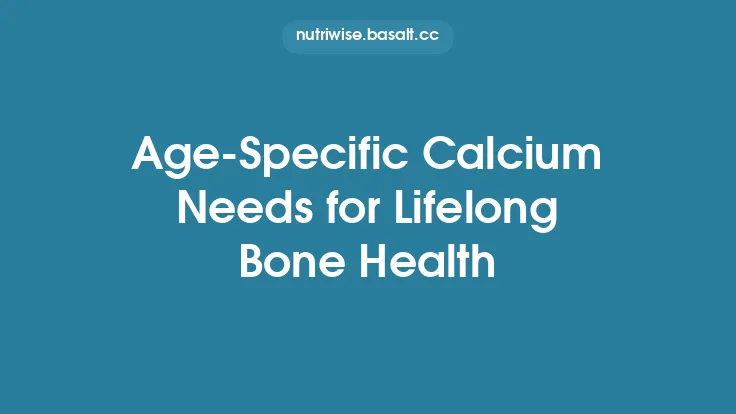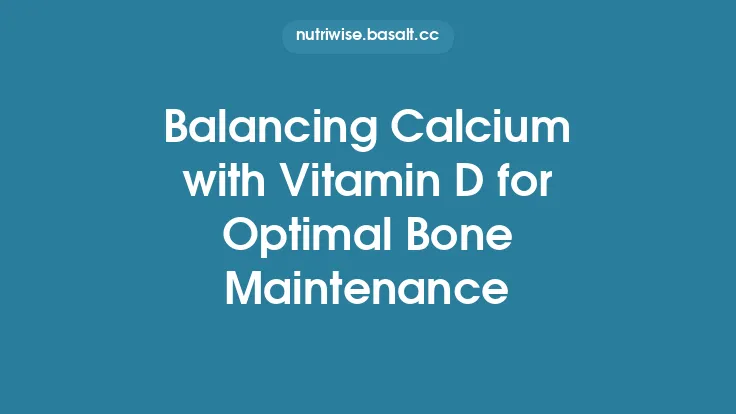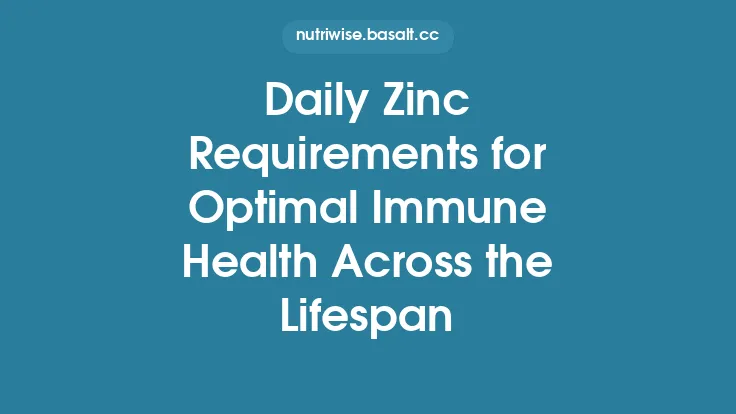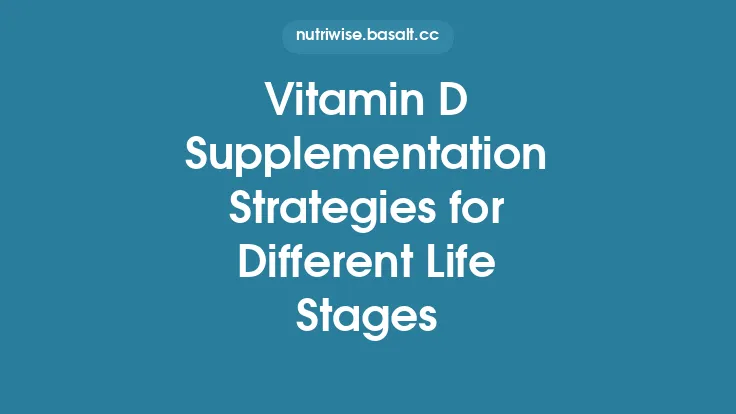Vitamin D is a fat‑soluble micronutrient that plays a pivotal role in maintaining the structural integrity of the skeletal system throughout the lifespan. While the mechanisms of calcium absorption and bone remodeling are well documented, determining the precise serum concentration of 25‑hydroxyvitamin D [25(OH)D] that optimally supports bone health remains a nuanced challenge. This article synthesizes current evidence, clinical guidelines, and practical considerations to delineate the optimal vitamin D status for lifelong skeletal health, emphasizing an evidence‑based, evergreen perspective.
Understanding Serum 25(OH)D as the Biomarker of Choice
The circulating level of 25(OH)D is the most reliable indicator of vitamin D status because it reflects total input from cutaneous synthesis, dietary intake, and supplemental sources, while also accounting for hepatic conversion of vitamin D₃ (cholecalciferol) and D₂ (ergocalciferol). Unlike the active hormone 1,25‑dihydroxyvitamin D, which is tightly regulated by parathyroid hormone (PTH) and calcium homeostasis, 25(OH)D concentrations vary widely and are directly linked to bone outcomes.
Key analytical considerations:
| Parameter | Recommended Method | Typical Reference Range |
|---|---|---|
| Sample type | Serum (or plasma) | — |
| Assay | LC‑MS/MS (gold standard) or standardized immunoassays (e.g., DiaSorin Liaison) | 20–80 ng/mL (50–200 nmol/L) |
| Units | ng/mL (commonly used in the U.S.) or nmol/L (international) | 1 ng/mL = 2.5 nmol/L |
| Precision | CV < 10 % at 20 ng/mL | — |
Standardization initiatives (e.g., Vitamin D Standardization Program, VDSP) have reduced inter‑laboratory variability, allowing clinicians to compare results across settings with confidence.
Defining the “Optimal” Range: Evidence from Bone Health Outcomes
1. Observational Cohort Data
Large prospective cohorts (e.g., the Framingham Osteoporosis Study, the Rotterdam Study) have consistently demonstrated a U‑shaped relationship between serum 25(OH)D and fracture risk. The nadir of fracture incidence typically occurs when 25(OH)D concentrations lie between 30–50 ng/mL (75–125 nmol/L). Below 20 ng/mL, the risk of hip and vertebral fractures rises sharply, while concentrations above 60 ng/mL have been associated with a modest, non‑significant increase in fracture risk, possibly reflecting confounding by high supplemental intake.
2. Randomized Controlled Trials (RCTs)
Meta‑analyses of RCTs that specifically measured bone mineral density (BMD) and fracture endpoints reveal:
- Supplementation to achieve ≥30 ng/mL reduces the odds of non‑vertebral fractures by ~12 % compared with placebo.
- Targeting 40–50 ng/mL yields the greatest incremental BMD gain (≈1–2 % at the lumbar spine) over 2–3 years, especially in postmenopausal women.
- Excessive dosing (>4000 IU/day) that pushes levels >80 ng/mL does not confer additional skeletal benefit and may increase hypercalciuria.
3. Consensus Guidelines
Professional societies have converged on the following target ranges for skeletal health:
| Organization | Target 25(OH)D (ng/mL) | Rationale |
|---|---|---|
| Endocrine Society | 30–50 | Balances fracture reduction with safety |
| Institute of Medicine (now National Academy of Medicine) | ≥20 (optimal ≥30) | Emphasizes sufficiency for calcium absorption |
| International Osteoporosis Foundation | 30–40 | Aligns with BMD response data |
| American Geriatrics Society | 30–45 | Addresses higher fall‑related fracture risk in elders |
Collectively, these recommendations suggest that 30–50 ng/mL (75–125 nmol/L) is the optimal window for lifelong bone health, with a pragmatic target of 40 ng/mL (100 nmol/L) for most adults.
Age‑Specific Considerations
Childhood and Adolescence (0–18 years)
- Critical period for peak bone mass acquisition. Studies indicate that maintaining 25(OH)D ≥30 ng/mL during puberty correlates with higher adult BMD.
- Safety margin: Upper intake level (UL) for children is lower (2,500 IU/day for ages 1–8; 4,000 IU/day for 9–18). Routine monitoring is advised when supplementation exceeds 1,000 IU/day.
Early Adulthood (19–40 years)
- Bone remodeling equilibrium. Maintaining 30–45 ng/mL supports optimal calcium balance without excess calcium loss.
- Lifestyle factors: High physical activity and adequate protein intake synergize with vitamin D to maximize bone accrual.
Middle Age (41–64 years)
- Onset of bone loss accelerates, especially in women after menopause. Targeting 35–45 ng/mL helps attenuate trabecular thinning.
- Comorbidities: Chronic kidney disease (CKD) stages 3–4 may impair conversion to active 1,25‑(OH)₂D; monitoring is essential.
Older Adults (≥65 years)
- Fracture risk peaks. Evidence supports a slightly higher target of 40–50 ng/mL to suppress secondary hyperparathyroidism and improve muscle function, thereby reducing falls.
- Renal conversion capacity declines; some clinicians consider measuring both 25(OH)D and intact PTH to fine‑tune dosing.
Factors Influencing Individual Vitamin D Requirements
| Factor | Mechanism | Impact on Target |
|---|---|---|
| Skin pigmentation | Melanin reduces UV‑B conversion | Darker skin may need 1.5–2× higher intake |
| Geographic latitude & season | Less UV‑B exposure at higher latitudes | Seasonal supplementation recommended |
| Body mass index (BMI) | Vitamin D sequestration in adipose tissue | Obese individuals often require 2–3× higher doses |
| Gastrointestinal absorption | Malabsorption syndromes (celiac, Crohn’s) | May need higher oral doses or intramuscular formulations |
| Medications | Anticonvulsants, glucocorticoids increase catabolism | Dose escalation and more frequent monitoring |
| Genetic polymorphisms (e.g., CYP2R1, GC) | Alter hepatic 25‑hydroxylation or binding protein levels | May explain inter‑individual variability; not routinely tested |
Understanding these modifiers enables clinicians to personalize supplementation strategies while aiming for the universal optimal range.
Practical Approach to Achieving and Maintaining Optimal Levels
- Baseline Assessment
- Order serum 25(OH)D and, if indicated, intact PTH and calcium.
- Document risk factors (BMI, skin type, medications, comorbidities).
- Initial Dosing Algorithm
- Deficiency (<20 ng/mL): 50,000 IU weekly for 8 weeks or 6,000 IU daily, then reassess.
- Insufficiency (20–30 ng/mL): 2,000–4,000 IU daily.
- Sufficiency (30–50 ng/mL): 800–2,000 IU daily for maintenance, adjusted for risk factors.
- Monitoring
- Re‑measure 25(OH)D 8–12 weeks after initiating therapy.
- Once stable, repeat testing every 1–2 years, or sooner if clinical status changes.
- Safety Checks
- Ensure serum calcium remains ≤10.5 mg/dL.
- Watch for hypercalciuria (>300 mg/24 h) in high‑dose regimens.
- Avoid chronic intake >10,000 IU/day, which exceeds the tolerable upper intake level (UL) for adults.
- Adjunctive Measures
- Encourage weight‑bearing exercise (e.g., walking, resistance training) to synergize with vitamin D.
- Optimize dietary calcium (1,000–1,200 mg/day) to ensure substrate availability for mineralization.
- Address fall risk (vision, balance training) especially in older adults.
Interplay Between Vitamin D, Parathyroid Hormone, and Bone Turnover
When 25(OH)D falls below ~30 ng/mL, PTH secretion rises (secondary hyperparathyroidism), leading to:
- Increased bone resorption to maintain serum calcium.
- Elevated bone turnover markers (e.g., serum C‑telopeptide, urinary N‑telopeptide).
- Reduced cortical thickness and heightened fracture susceptibility.
Restoring 25(OH)D to the optimal range suppresses PTH, normalizes turnover markers, and stabilizes bone microarchitecture. This physiological cascade underscores why the optimal vitamin D window is not merely a laboratory target but a functional determinant of skeletal remodeling dynamics.
Special Populations: When the Standard Range May Need Adjustment
| Population | Reason for Adjustment | Suggested Target |
|---|---|---|
| Chronic kidney disease (stage 3–4) | Impaired 1α‑hydroxylase activity; risk of adynamic bone disease | 30–40 ng/mL, with close monitoring of calcium, phosphate, and PTH |
| Patients on high‑dose glucocorticoids | Accelerated bone loss, increased catabolism of vitamin D | 40–50 ng/mL, possibly higher initial loading dose |
| Post‑bariatric surgery | Malabsorption of fat‑soluble vitamins | 40–50 ng/mL, consider intramuscular vitamin D₃ if oral fails |
| Athletes with high bone turnover | Demands for rapid remodeling | 35–45 ng/mL, ensure adequate calcium and protein intake |
In each case, individualized assessment and interdisciplinary collaboration (e.g., endocrinology, nephrology, nutrition) are essential.
Toxicity and Upper Limits: Guarding Against Over‑Correction
Vitamin D toxicity is rare but can occur with chronic intake >10,000 IU/day, leading to:
- Hypercalcemia (symptoms: polyuria, polydipsia, nausea, neurocognitive changes).
- Nephrocalcinosis and renal impairment.
- Vascular calcification in extreme cases.
Serum 25(OH)D levels >150 ng/mL (≥375 nmol/L) are generally considered potentially harmful. Routine screening for toxicity is unnecessary unless patients are on high‑dose regimens or present with unexplained hypercalcemia.
Future Directions and Emerging Research
- Genotype‑guided dosing: Ongoing trials are evaluating whether CYP2R1 and GC polymorphisms can predict optimal dosing, potentially reducing the need for trial‑and‑error.
- Bone quality imaging: High‑resolution peripheral quantitative computed tomography (HR‑pQCT) may allow direct observation of microarchitectural changes in response to vitamin D optimization.
- Combined nutrient strategies: Research into synergistic effects of vitamin D with vitamin K2, magnesium, and omega‑3 fatty acids on bone matrix quality is expanding.
These advances promise to refine the definition of “optimal” beyond serum concentrations, integrating functional outcomes and personalized medicine.
Key Take‑aways
- Optimal serum 25(OH)D for lifelong skeletal health lies between 30–50 ng/mL (75–125 nmol/L), with a pragmatic target of ~40 ng/mL.
- Achieving this range reduces fracture risk, suppresses secondary hyperparathyroidism, and supports favorable bone remodeling.
- Individual factors—age, skin pigmentation, BMI, comorbidities, medications—must inform dosing and monitoring strategies.
- Regular assessment, safe supplementation, and complementary lifestyle measures (weight‑bearing exercise, adequate calcium) are essential for maintaining optimal vitamin D status.
- Avoid excessive dosing; toxicity is rare but preventable with adherence to established upper intake limits.
By integrating evidence‑based targets with personalized clinical judgment, healthcare providers can ensure that vitamin D contributes effectively to robust, resilient bones from childhood through the senior years.





